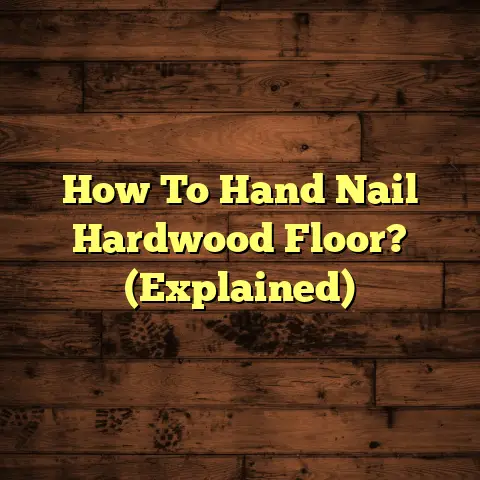Stop Tile Floor Squeaks (7 Easy Steps!)
They’re durable, resistant to moisture, and add a touch of elegance to any space.
I’ve laid down countless tiles in my career, and I’ve seen firsthand how long-lasting they can be.
But let’s be real, even the toughest tile floors can sometimes develop annoying squeaks.
It’s like a tiny gremlin living under your feet, constantly reminding you of its presence.
And trust me, I understand how irritating that can be!
That’s why I’m here to help.
Think of me as your friendly neighborhood flooring expert, ready to share my knowledge.
Addressing those squeaks isn’t just about silencing the noise; it’s about maintaining the integrity and longevity of your flooring.
A small squeak today can turn into a cracked tile tomorrow.
In this article, I’m going to walk you through seven easy steps to stop those pesky tile floor squeaks.
I’ll share my insider tips and tricks, so you can tackle this problem like a pro.
Ready to get started? Let’s dive in!
Section 1: Understanding the Causes of Tile Floor Squeaks
Okay, so you’ve got a squeaky tile floor. The first step is understanding why it’s happening.
It’s like a doctor trying to diagnose a patient; you need to know the root cause to prescribe the right treatment.
So, what are the usual suspects behind those squeaks?
The Installation Process
Believe it or not, a lot of squeaks can be traced back to the initial installation.
Think of it like building a house; if the foundation isn’t solid, the whole structure is at risk.
Improper laying of tiles is a common culprit.
If the tiles weren’t properly set in the mortar or adhesive, they can become loose over time.
I’ve seen it happen countless times.
Sometimes, installers rush the job or don’t use enough adhesive.
This can create air pockets or weak spots that eventually lead to movement and squeaking.
The Substrate Beneath the Tile
The substrate, which is the material beneath the tile (usually concrete or plywood), plays a crucial role in the floor’s stability.
If the subfloor isn’t level or stable, it can cause the tiles to shift and squeak.
Imagine trying to build a puzzle on a wobbly table; it’s just not going to work.
A common problem is an uneven subfloor.
If there are dips or bumps, the tiles won’t sit properly, and they’ll be prone to movement.
Another issue is a subfloor that’s not properly secured.
If the plywood is loose or the concrete is cracked, it can create instability that affects the tiles above.
Changes in Temperature and Humidity
This is one that a lot of people don’t think about, but it’s a big one.
Changes in temperature and humidity can cause expansion and contraction in both the tiles and the subfloor.
Think about how wood swells in humid weather and shrinks in dry weather.
The same principle applies to tile and other flooring materials.
In areas with extreme temperature fluctuations, this problem can be even more pronounced.
I’ve worked on projects where the floor was perfectly fine in the summer but started squeaking in the winter due to the cold.
The Age of the Flooring and Wear and Tear
Like anything else, tile floors are subject to wear and tear over time.
The constant foot traffic, furniture movement, and general use can take a toll on the tiles and the adhesive.
Over the years, the adhesive can become brittle and lose its grip, allowing the tiles to move slightly.
This movement, even if it’s just a fraction of an inch, can create those annoying squeaks.
Also, the grout between the tiles can deteriorate over time, leaving gaps that allow dirt and debris to get underneath the tiles.
This debris can act like tiny ball bearings, causing the tiles to shift and squeak.
To give you a clearer picture, here’s a table summarizing the causes:
| Cause | Description | Example read more »





